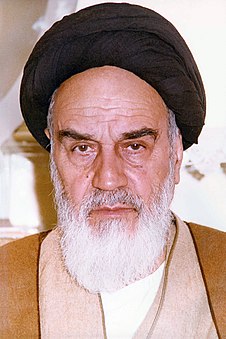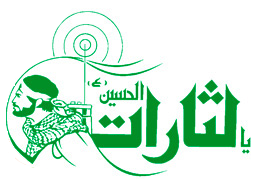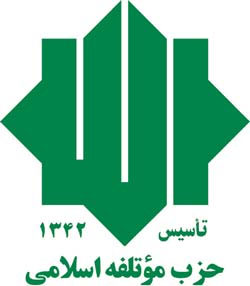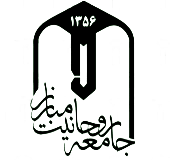
Sayyid Ruhollah Mūsavi Khomeini, known in the Western world as Ayatollah Khomeini, was an Iranian politician and marja. He was the founder of the Islamic Republic of Iran and the leader of the 1979 Iranian Revolution that saw the overthrow of the last Shah of Iran, Mohammad Reza Pahlavi, and the end of 2,500 years of Persian monarchy. Following the revolution, Khomeini became the country's Supreme Leader, a position created in the constitution of the Islamic Republic as the highest-ranking political and religious authority of the nation, which he held until his death. He was succeeded by Ali Khamenei on 4 June 1989.

The Iranian Revolution was a series of events that involved the overthrow of the monarch of Iran, Mohammad Reza Shah Pahlavi, and the replacement of his government with an Islamic republic under the Grand Ayatollah Ruhollah Khomeini, a leader of one of the factions in the revolt. The movement against the United States-backed monarchy was supported by various leftist and Islamist organizations and student movements.

The Alliance of Builders or Developers of Islamic Iran, usually shortened to Abadgaran, was an Iranian conservative political federation of parties and organizations. Described as "Iran's neocons", main groups within the alliance were Front of Followers of the Line of the Imam and the Leader members and Society of Devotees of the Islamic Revolution.

The Islamic Front for the Liberation of Bahrain was a Shia islamist militant group that advocated theocratic rule in Bahrain from 1981 to the 1990s. It was based in Iran and trained and financed by Iranian intelligence and Revolutionary Guards.

Grand Ayatollah Sayyid Muhammad ibn Mahdi al-Hussaini al-Shirazi, commonly known as Mohammad Al-Shirazi, was a Twelver Shia Marja', politician and religious leader.

Velayat-e faqih, also known as Islamic Government, is a book by the Iranian Muslim cleric, faqīh, and revolutionary Ayatollah Ruhollah Khomeini, first published in 1970, and probably the most influential document written in modern times in support of theocratic rule.

Ansar-e-Hezbollah is a conservative paramilitary organization in Iran. According to the Columbia World Dictionary of Islamism, it is a "semi-official quasi-clandestine organization of a paramilitary character that performs vigilante duties". Hossein Allahkaram, one of the organization's known leaders has described it as "groups of young war veterans who, based on their revolutionary-Islamic duty, claim to be carrying out the Imam's will and rectifying existing shortcomings in Iran".

Mahmoud Taleghani was an Iranian theologian, Muslim reformer, democracy advocate and a senior Shi'a cleric of Iran. Taleghani was a contemporary of the Iranian Revolutionary leader Ayatollah Ruhollah Khomeini and a leader in his own right of the movement against Shah Mohammad Reza Pahlavi. A founding member of the Freedom Movement of Iran, he has been described as a representative of the tendency of many "Shia clerics to blend Shia with Marxist ideals in order to compete with leftist movements for youthful supporters" during the 1960s and 1970s. His "greatest influence" has been said to have been in "his teaching of Quranic exegesis," as many later revolutionaries were his students.

Khomeinism is the founding ideology of the Islamic Republic of Iran. Impact of the religious and political ideas of the leader of the 1979 Iranian Revolution, Grand Ayatollah Ruhollah Khomeini include replacing Iran's millennia-old monarchy with theocracy. Khomeini declared Islamic jurists the true holders of not only religious authority but political authority, who must be obeyed as "an expression of obedience to God", and whose rule has "precedence over all secondary ordinances [in Islam] such as prayer, fasting, and pilgrimage."
The Muslim People's Republic Party (MPRP) or Islamic People's Republican Party was a short-lived party associated with Shia Islamic cleric Shariatmadari. It was founded in 1979 during the Iranian Revolution as a "moderate, more liberal counterweight" to the theocratic, Islamist Islamic Republican Party (IRP) of Ayatollah Ruhollah Khomeini, and disbanded in 1980.
The consolidation of the Iranian Revolution refers to a turbulent process of Islamic Republic stabilization, following the completion of the revolution. After the Shah of Iran and his regime were overthrown by revolutionaries in February 1979, Iran was in a "revolutionary crisis mode" from this time until 1982 or 1983. Its economy and the apparatus of government collapsed. Military and security forces were in disarray.

The Islamic Coalition Party is a conservative political party in Iran that favors economic liberalism.
A constitutional referendum was held in Iran on 2 and 3 December 1979. The new Islamic constitution was approved by 99.5% of voters, with a 71.6% turnout.

Abbas Mohammad Montazeri was an Iranian cleric and military figure. He was one of the founding members and early chiefs of the Islamic Revolutionary Guard Corps. He was killed in a 1981 bombing in Tehran.

Sayyid Mostafa Khomeini was an Iranian cleric and the son of Ayatollah Khomeini. He died before the 1979 revolution.
On 7 January 1989, Ayatollah Ruhollah Khomeini, supreme leader of Iran, sent a letter to Mikhail Gorbachev, the General Secretary of the Soviet Union. This letter was Khomeini's only written message to a foreign leader. Khomeini's letter was delivered by the Iranian politicians Abdollah Javadi-Amoli, Mohammad-Javad Larijani, and Marzieh Hadidchi. In the letter, Khomeini declared that Communism was dissolving within the Soviet bloc, and invited Gorbachev to consider Islam as an alternative to communist ideology.

America can't do a damn thing against us is a slogan originally used by the former Supreme Leader of Iran, Ayatollah Ruhollah Khomeini during the Iran hostage crisis, for the first time to assure the Iranians that the United States would not be able to restore the ousted Shah of Iran back to the Persian throne. The statement then became an official slogan for the Iranian Revolution which resulted in the establishment of an Islamic Republic under Khomeini's rule.

Ruhollah Khomeini's life in exile refers to days of exile that Ruhollah Khomeini known as the leader of the Iranian revolution, spent in Turkey, Iraq and France from 1964 to 1989. Between August and December 1978, strikes and demonstrations paralyzed the country. The Shah left Iran for exile on 16 January 1979, as the last Persian monarch, leaving his duties to a regency council and Shapour Bakhtiar who was an opposition-based prime minister. Ayatollah Khomeini was invited back to Iran by the government,and returned to Tehran to a greeting by several million Iranians.


















